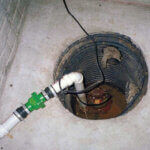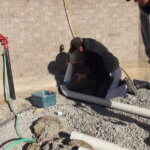What Size Sump Pump Do I Need?
A sump pump, also called a basement pump, helps keep water away from your Chicago, Illinois, home’s foundation. It removes groundwater from a sump pit underneath your basement floor. Then, it transfers the excess water away from your foundation. In areas that often get heavy rain or flooding, a sump pump is essential for preventing costly water damage. The right sump pump can help you avoid mold, mildew, and bad smells as well. Here are some of the most common factors you should consider when you decide what size sump pump your home needs.
Water Flow

Some areas have more rain or flooding than others, and they often need larger sump pumps. If you’re installing a sump pump for the first time, you’ll need a capacity of 14 gallons per minute for every 1,000 square feet with a home on sandy soil. On more dense clay, your sump pump will need to handle 8 gallons of water per minute for every 1,000 square feet. If your basement is below the water table or your yard is below the surrounding landscape, you could need a larger sump pump.
If your home already has a sump pit, you can make a more accurate calculation. Most sump pits have an 18-inch diameter, and you should measure your sump pit to make sure it’s not a different size.
On a day with heavy rain, measure the water level in your sump pit. If you already have a sump pump, turn it off or unplug it. After one minute, check the water level again. With an 18-inch sump pit, one inch of additional water is equal to one gallon. After you finish your measurements, remember to plug your sump pump back in. For the best results, repeat this procedure a few different times on different days and then average the results.
To find the typical number of gallons of water coming into the sump pit per hour, multiply the number of inches the water rose by 60. Then, multiply the result by 1.5 to provide a margin of error in case of a heavy storm. If the area is particularly prone to flooding, you can multiply by two instead for even more protection. However, larger sump pumps are more expensive. They can also consume more power, raising your utility expenses.
If your home gets lots of rain, you could need a larger sump pit as well. A 24-inch sump pit can hold 2 gallons per inch of water. If you get more than 1,800 gallons of water per hour, consider expanding your sump pit or installing a larger one. However, a sump pit that’s too large could cause the sump pump to turn on and off too often. This happens because the water level stays near the automatic cut-off level for the sump pump, and it often causes additional wear and tear over time.
You can prevent this issue by adding an adjustable float switch that lets you determine the water level needed for the sump pump to activate. That way, your sump pump won’t activate and shut down too often and there will be enough water to cool the motor when it’s running.
Total Dynamic Head
Total dynamic head is a combination of the static head and the friction head. Static head, also called vertical lift, is the vertical distance between the place where water enters your sump pump and the place where the pump discharges the water from your basement. A higher static head means your sump pump needs to work harder to push water out of the sump pit and keep it from damaging your basement.
Friction head is the force created from friction when water contacts the inner sides of the pipe from the sump pump to the outside of your home. Longer, thinner pipes have greater friction head. Pipe elbows, valves, and other fittings can increase friction head as well. Friction isn’t a major factor for most home sump pumps, but you should get a plumber to assess your friction head if you have a particularly thin pipe running from your sump pump. You should also consider friction head if the pipe from the sump pump is more than about 30 feet long.
You can add the static head to the friction head to get the total dynamic head. Most sump pumps provide a graph or chart with the gallons of water per minute they can move with a variety of total dynamic head values.
Horsepower
If you’re replacing your sump pump, you should choose a replacement with the same horsepower. You can find the horsepower rating of your existing sump pump on its side, along with other relevant information. Consider increasing the horsepower if you had any mechanical problems with the previous model. Most sump pumps provide between 0.25 and 1.0 horsepower, and a 0.5-horsepower sump pump can move about 3,000 gallons of water per hour.
A sump pump that gives 0.33 horsepower can typically handle 7 to 10 feet of vertical lift or static head. This calculation assumes the pipe has one 90-degree elbow and takes the water from the sump pump a horizontal distance of between 3 and 25 feet. A 0.5-horsepower sump pump can handle 35 to 40% more water and higher vertical lifts for water going through your discharge pipe. A 0.75- to 1.0-horsepower sump pump can usually take care of a static head from 20 to 30 feet with a pipe that’s around 150 to 250 feet long.
To learn more about sump pumps and get help choosing the best model for your needs, contact us at Allied Plumbing & Heating Supply Co. Our experienced, friendly staff members can help you choose and maintain quality sump pumps and other equipment. We’re devoted to providing outstanding service, and we’re a family-owned business that’s been open for more than 30 years. You can visit us on weekdays from 7:30 a.m. to 5 p.m. and on Saturdays from 7:30 a.m. to 2 p.m.



